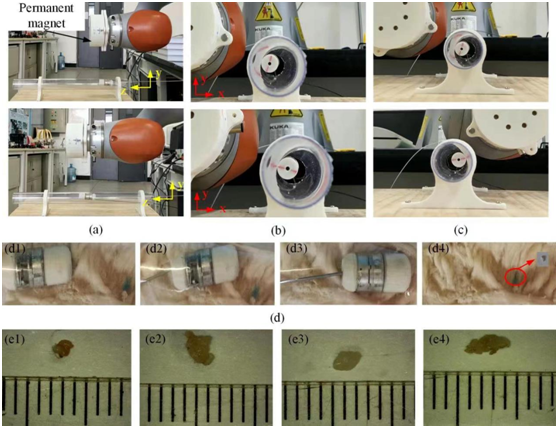Chinese scientists have developed the capsule robot (CR)—a new strategy for biopsy sampling which is expected to replace colonoscopy.

Movement performance test of the new biopsy capsule robot developed at Tianjin University and biopsy samplings
The team of researchers, led by Song Zhibin from Tianjin University, has developed a novel biopsy sampling strategy using the CR. The robot they have developed can cut suspicious diseased tissue in the colon at high speed,avoiding the tissue tearing that occurs in existing biopsy methods.The results have been published inCyborg and Bionic Systems, a high-level journal of the China Science and Technology Journal Excellence Action Plan.
Among human digestive tract diseases, colorectal cancer is an invisible killer that could directly threaten human health.Colonoscopy is a gold standard for colorectal cancer diagnosis, which allows doctors to visually inspect the lesions in the colorectum and retrieve a biopsy to confirm pathological diagnosis.Traditional colonoscopy may cause discomfort to patients, while capsule endoscopy, as an endoscopic diagnostic method, can reduce the user’s discomfort and thus has a broad prospect.However, the currently used capsule endoscope cannot well perform biopsy sampling. Although the academic community has proposed a variety of capsule endoscope biopsy strategies, it still causes many problems such as tearing and adhesion when achieving colonic tissue.
"Capsule endoscopy is also called ‘capsule robot’. Making use of CRs to inspect the stomach, esophagus and other areas can not only provide visual information, but also perform biopsy operations. It is part of the main development direction of digestive tract disease screening in the future." Said Song Zhibin, Associate Professor from the School of Mechanical Engineering of Tianjin University.
The research presents a new strategy for biopsy sampling by “proposing high-speed rotating blade for the biopsy capsule robot (BCR)”, and also embedding a small permanent magnet for the CR equipped with a high-speed rotating blade to control its movement via an external magnetic field.
The blade is triggered by a tightened spiral spring that could provide more instantaneous power than a motor or a magnet with the identical mass,while effectively avoiding interference between motion control and biopsy manipulation.At the same time, the team also designed the trigger mechanism to guarantee reliable sampling.
According to the verification results of vitro porcine large intestine biopsy sampling, the novel BCR can achieve multiple biopsy triggersand effectively avoid tearing of the soft tissue when its cutting speed reaches a certain value, which is expected to become a promising method of clinical gastrointestinal examination.
“The results of this research can realize the function of multiple biopsies in one examination, and provide technical support for the clinical application of CRs with biopsy function in the future.” Song said, adding that "It will further improve the performance of diagnosis and treatment of gastrointestinal diseases, and will also be the future direction of capsule robots.”
By Chu Jingyi
Editors: School of Mechanical Engineering, Sun Xiaofang






